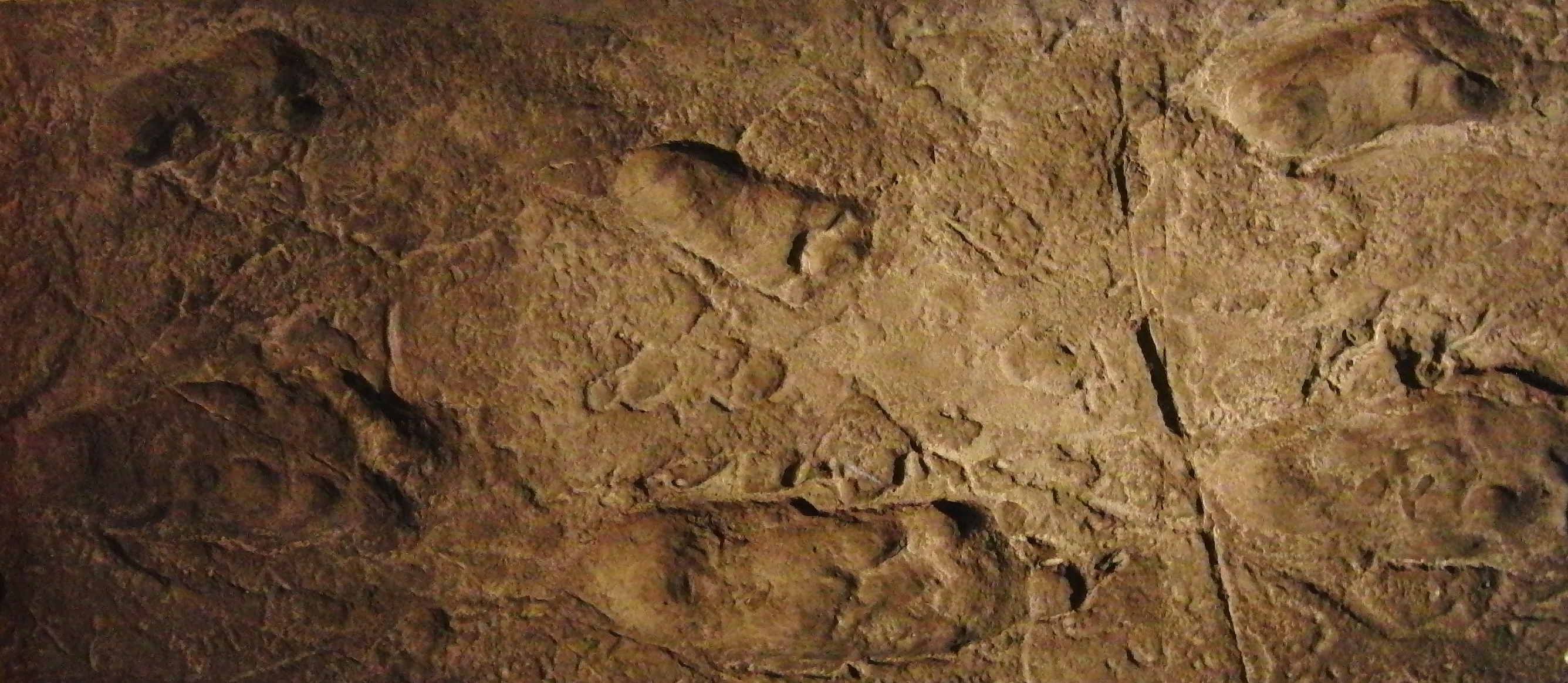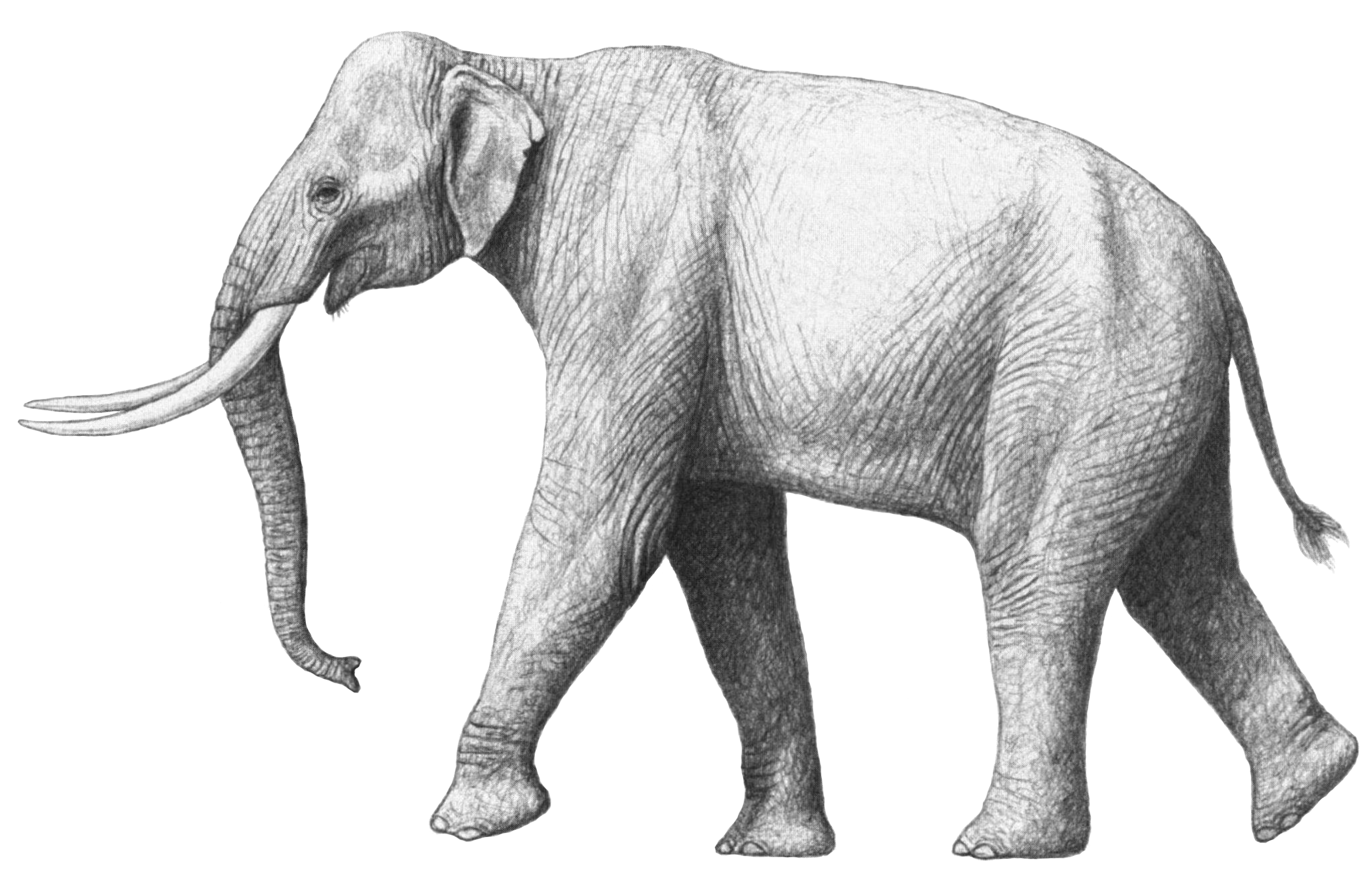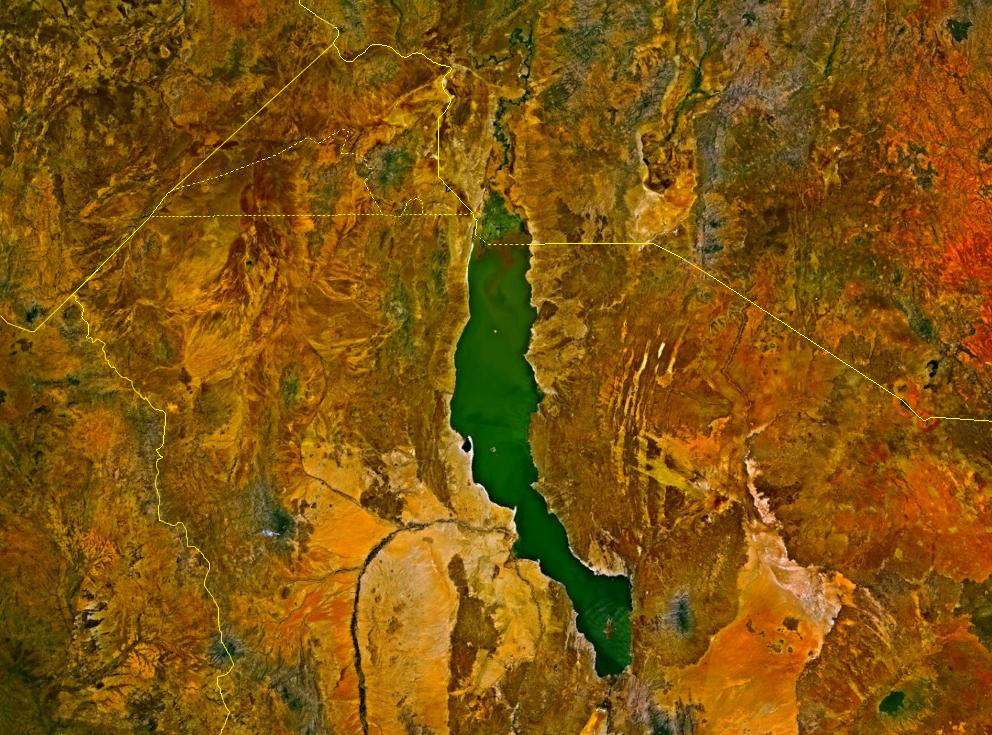|
Australopithecus Aethiopicus
''Paranthropus aethiopicus'' is an extinct species of robust australopithecine from the Late Pliocene to Early Pleistocene of East Africa about 2.7–2.3 million years ago. However, it is much debated whether or not ''Paranthropus'' is an invalid grouping and is synonymous with ''Australopithecus'', so the species is also often classified as ''Australopithecus aethiopicus''. Whatever the case, it is considered to have been the ancestor of the much more robust '' P. boisei''. It is debated if ''P. aethiopicus'' should be subsumed under ''P. boisei'', and the terms ''P. boisei'' sensu lato ("in the broad sense") and ''P. boisei'' sensu stricto ("in the strict sense") can be used to respectively include and exclude ''P. aethiopicus'' from ''P. boisei''. Like other ''Paranthropus'', ''P. aethiopicus'' had a tall face, thick palate, and especially enlarged cheek teeth. However, likely due to its archaicness, it also diverges from other ''Paranthropus'', with some aspects resembling th ... [...More Info...] [...Related Items...] OR: [Wikipedia] [Google] [Baidu] |
Pliocene
The Pliocene ( ; also Pleiocene) is the epoch (geology), epoch in the geologic time scale that extends from 5.33 to 2.58See the 2014 version of the ICS geologic time scale million years ago (Ma). It is the second and most recent epoch of the Neogene Period in the Cenozoic, Cenozoic Era. The Pliocene follows the Miocene Epoch and is followed by the Pleistocene Epoch. Prior to the 2009 revision of the geologic time scale, which placed the four most recent major glaciations entirely within the Pleistocene, the Pliocene also included the Gelasian Stage, which lasted from 2.59 to 1.81 Ma, and is now included in the Pleistocene. As with other older geologic periods, the Stratum, geological strata that define the start and end are well-identified but the exact dates of the start a ... [...More Info...] [...Related Items...] OR: [Wikipedia] [Google] [Baidu] |
Sensu Lato
''Sensu'' is a Latin word meaning "in the sense of". It is used in a number of fields including biology, geology, linguistics, semiotics, and law. Commonly it refers to how strictly or loosely an expression is used in describing any particular concept, but it also appears in expressions that indicate the convention or context of the usage. Common qualifiers ''Sensu'' is the ablative case of the noun ''sensus'', here meaning "sense". It is often accompanied by an adjective (in the same case). Three such phrases are: * – "in the strict sense", abbreviation ''s.s.'' or ''s.str.''; * – "in the broad sense", abbreviation ''s.l.''; * – "in a relaxed, generous (or 'ample') sense", a similar meaning to ''sensu lato''. Søren Kierkegaard uses the phrase ''sensu eminenti'' to mean "in the pre-eminent r most important or significantsense". When appropriate, comparative and superlative adjectives may also be used to convey the meaning of "more" or "most". Thus ''sensu stricto' ... [...More Info...] [...Related Items...] OR: [Wikipedia] [Google] [Baidu] |
Paranthropus
''Paranthropus'' is a genus of extinct hominin which contains two widely accepted species: ''Paranthropus robustus, P. robustus'' and ''P. boisei''. However, the validity of ''Paranthropus'' is contested, and it is sometimes considered to be synonym (taxonomy), synonymous with ''Australopithecus''. They are also referred to as the robust australopithecines. They lived between approximately 2.9 and 1.2 million years ago (mya) from the end of the Pliocene to the Middle Pleistocene. ''Paranthropus'' is characterised by robust skulls, with a prominent gorilla-like sagittal crest along the midline—which suggest strong chewing muscles—and broad, herbivorous teeth used for grinding. However, they likely preferred soft food over tough and hard food. Typically, ''Paranthropus'' species were generalist feeders, but while ''P. robustus'' was likely an omnivore, ''P. boisei'' seems to have been herbivorous, possibly preferring abundant bulbotubers. Paranthropoids were bipeds. Despite th ... [...More Info...] [...Related Items...] OR: [Wikipedia] [Google] [Baidu] |
Paranthropus Robustus
''Paranthropus robustus'' is a species of robust australopithecine from the Early and possibly Middle Pleistocene of the Cradle of Humankind, South Africa, about 2.27 to 0.87 (or, more conservatively, 2 to 1) million years ago. It has been identified in Kromdraai, Swartkrans, Sterkfontein, Gondolin, Cooper's, and Drimolen Caves. Discovered in 1938, it was among the first early hominins described, and became the type species for the genus ''Paranthropus''. However, it has been argued by some that ''Paranthropus'' is an invalid grouping and synonymous with ''Australopithecus'', so the species is also often classified as ''Australopithecus robustus''. Robust australopithecines—as opposed to gracile australopithecines—are characterised by heavily built skulls capable of producing high stresses and bite forces, as well as inflated cheek teeth (molars and premolars). Males had more heavily built skulls than females. ''P. robustus'' may have had a genetic susceptibi ... [...More Info...] [...Related Items...] OR: [Wikipedia] [Google] [Baidu] |
Koobi Fora
Koobi Fora refers primarily to a region around Koobi Fora Ridge, located on the eastern shore of Lake Turkana in the territory of the nomadic Gabbra people. According to the National Museums of Kenya, the name comes from the Gabbra language: The ridge itself is an outcrop of mainly Pliocene/Pleistocene sediments. It is composed of claystones, siltstones, and sandstones that preserve numerous fossils of terrestrial mammals, including early hominin species. Presently, the ridge is being eroded into a badlands terrain by a series of ephemeral rivers that drain into the northeast portion of modern Lake Turkana. In 1968 Richard Leakey established the Koobi Fora Base Camp on a large sandspit projecting into the lake near the ridge, which he called the Koobi Fora Spit. Consequently, the government of Kenya in 1973 reserved the region as Sibiloi National Park, establishing a headquarters for the National Museums of Kenya on Koobi Fora Spit. The reserve is well-maintained and i ... [...More Info...] [...Related Items...] OR: [Wikipedia] [Google] [Baidu] |
Francis Clark Howell
Francis Clark Howell (November 27, 1925 – March 10, 2007), generally known as F. Clark Howell, was an American anthropologist. Born in Kansas City, Missouri, F. Clark Howell grew up in Kansas, where he became interested in natural history. He served in the U.S. Navy during World War II, from 1944 to 1946 in the Pacific Theater. Howell was educated at the University of Chicago, where he received his Ph.B., A.M. and Ph.D. degrees under the tutelage of Sherwood L. Washburn. Dr. Howell died of metastatic lung cancer on March 10, 2007, at age 81 at his home in Berkeley, California. Academic career Howell began his career in the Anatomy Department of Washington University in St. Louis in 1953, and stayed there for only two years before moving back to his alma mater, the University of Chicago. He went on to spend the next 25 years of his career there in the Department of Anthropology. He achieved a professorship in 1962 and became chairman of the department in 1966. In 1970, Ho ... [...More Info...] [...Related Items...] OR: [Wikipedia] [Google] [Baidu] |
Paranthropus Aethiopicus Africa
''Paranthropus'' is a genus of extinct hominin which contains two widely accepted species: '' P. robustus'' and '' P. boisei''. However, the validity of ''Paranthropus'' is contested, and it is sometimes considered to be synonymous with ''Australopithecus''. They are also referred to as the robust australopithecines. They lived between approximately 2.9 and 1.2 million years ago (mya) from the end of the Pliocene to the Middle Pleistocene. ''Paranthropus'' is characterised by robust skulls, with a prominent gorilla-like sagittal crest along the midline—which suggest strong chewing muscles—and broad, herbivorous teeth used for grinding. However, they likely preferred soft food over tough and hard food. Typically, ''Paranthropus'' species were generalist feeders, but while ''P. robustus'' was likely an omnivore, ''P. boisei'' seems to have been herbivorous, possibly preferring abundant bulbotubers. Paranthropoids were bipeds. Despite their robust heads, they had comparativel ... [...More Info...] [...Related Items...] OR: [Wikipedia] [Google] [Baidu] |
Laetoli
Laetoli is a pre-historic site located in Enduleni ward of Ngorongoro District in Arusha Region, Tanzania. The site is dated to the Plio-Pleistocene and famous for its Hominina footprints, preserved in volcanic ash. The site of the Laetoli footprints (Site G) is located 45 km south of Olduvai gorge. The location and tracks were discovered by archaeologist Mary Leakey and her team in 1976, and were excavated by 1978. Based on analysis of the footfall impressions "The Laetoli Footprints" provided convincing evidence for the theory of bipedalism in Pliocene Hominina and received significant recognition by scientists and the public. Since 1998, paleontological expeditions have continued under the leadership of Amandus Kwekason of the National Museum of Tanzania and Terry Harrison of New York University, leading to the recovery of more than a dozen new Hominina finds, as well as a comprehensive reconstruction of the paleoecology. The site is a registered National Historic Sites of ... [...More Info...] [...Related Items...] OR: [Wikipedia] [Google] [Baidu] |
Shungura Formation
The Shungura Formation is a stratigraphic formation located in the Omo River (Ethiopia), Omo river basin in Ethiopia. It dates to the Pliocene, Late Pliocene to Early Pleistocene. Oldowan tools have been found in the formation, suggesting early use of stone tools by hominins. Among many others, fossils of ''Panthera'' were found in Member G of the formation.Sabol, 2011, p.230Boaz, N. T., Howell, F. C., & McCrossin, M. L. (1982). Faunal age of the Usno, Shungura B and Hadar Formations, Ethiopia. Nature, 300(5893), 633–635. https://doi.org/10.1038/300633A0 Geology The formation comprises sandstones, siltstones, claystones and tuff, deposited in a fluvial to river delta, deltaic lacustrine depositional environment, environment. Paleobiota Fossil content Among many others, the following fossils have been reported from the formation:Sillen, A. (1986). Biogenic and Diagenetic Sr/Ca in Plio-Pleistocene Fossils of the Omo Shungura Formation. Paleobiology, 12(3), 311–323. http:/ ... [...More Info...] [...Related Items...] OR: [Wikipedia] [Google] [Baidu] |
Kenya
Kenya, officially the Republic of Kenya, is a country located in East Africa. With an estimated population of more than 52.4 million as of mid-2024, Kenya is the 27th-most-populous country in the world and the 7th most populous in Africa. Kenya's capital and largest city is Nairobi. Its second-largest and oldest city is Mombasa, a major port city located on Mombasa Island. Other major cities within the country include Kisumu, Nakuru & Eldoret. Going clockwise, Kenya is bordered by South Sudan to the northwest (though much of that border includes the disputed Ilemi Triangle), Ethiopia to the north, Somalia to the east, the Indian Ocean to the southeast, Tanzania to the southwest, and Lake Victoria and Uganda to the west. Kenya's geography, climate and population vary widely. In western, rift valley counties, the landscape includes cold, snow-capped mountaintops (such as Batian, Nelion and Point Lenana on Mount Kenya) with vast surrounding forests, wildlife and ... [...More Info...] [...Related Items...] OR: [Wikipedia] [Google] [Baidu] |
Lake Turkana
Lake Turkana () is a saline lake in the Kenyan Rift Valley, in northern Kenya, with its far northern end crossing into Ethiopia. It is the world's largest permanent desert lake and the world's largest alkaline lake. By volume it is the world's fourth-largest salt lake after the Caspian Sea, Issyk-Kul, and Lake Van (passing the shrinking South Aral Sea), and among all lakes it ranks 24th. Lake Turkana is now threatened by the construction of the Gilgel Gibe III Dam in Ethiopia due to the damming of the Omo river which supplies most of the lake's water. Although the lake commonly has been—and to some degree still is—used for drinking water, its salinity (slightly brackish) and very high levels of fluoride (much higher than in fluoridated water) generally make it unsuitable for drinking directly, and it has also been a source of diseases spread by contaminated water. Increasingly, communities on the lake's shores rely on underground springs for drinking water. The ... [...More Info...] [...Related Items...] OR: [Wikipedia] [Google] [Baidu] |
Australopithecus Afarensis
''Australopithecus afarensis'' is an extinct species of australopithecine which lived from about 3.9–2.9 million years ago (mya) in the Pliocene of East Africa. The first fossils were discovered in the 1930s, but major fossil finds would not take place until the 1970s. From 1972 to 1977, the International Afar Research Expedition—led by anthropologists Maurice Taieb, Donald Johanson and Yves Coppens—unearthed several hundreds of hominin specimens in Hadar, Ethiopia, Hadar, Ethiopia, the most significant being the exceedingly well-preserved skeleton AL 288-1 ("Lucy (Australopithecus), Lucy") and the site AL 333 ("the First Family"). Beginning in 1974, Mary Leakey led an expedition into Laetoli, Tanzania, and notably recovered fossil trackways. In 1978, the species was first species description, described, but this was followed by arguments for splitting the wealth of specimens into different species given the wide range of variation which had been attributed to sexual dimorphi ... [...More Info...] [...Related Items...] OR: [Wikipedia] [Google] [Baidu] |









